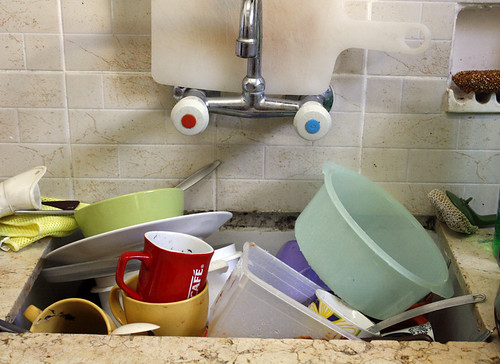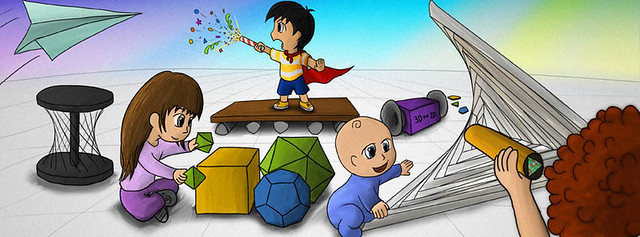Thinking in Threes
The more I learn about the exquisite connections between shape, number and nature, the more convinced I am that combining numbers and shapes is a win-win situation for building number sense in young children. For example, consider the benefits of exploring the basic, but charming, triangle. This mesmerizing video provides some exquisite, thought provoking examples of three-ness:
httpv://youtu.be/1ztfo5S5oL4
What three-ness did you notice? I noticed three colors, triangles with three sides and three corners, many different types of triangles and, best of all, a lovely waltz rhythm (1-2-3, 1-2-3)! The video is also a demonstration of the power of doubling – double 3 is 6 (a hexagon or a snowflake) and double 6 is 12 (a dodecagon). My seven-year-old watched the video all the way to the end the second time (the first time she was waltzing along to the music) and said: “T. [a friend] and I saw a big snowflake once – it looked like that!”
Back in November I read a Moebius Noodles post that mentioned ‘iconic numbers’ — numbers that are so ubiquitous in our daily lives that we don’t really notice them but are perfect for building number sense. One iconic number object is the clover.
I, for one, had never given its ‘three-ness’ much thought until the day my daughter brought me one with a clear triangle scribed on its leaves. As soon as I saw it I knew exactly what to do with it.
We picked more clovers, flattened and dried them in a sketchbook, and finally found some time (and a glue stick) to paste them down. Although my daughter sometimes eschews direct participation in the projects I think up, she is generally always around as I’m making something. In this particular case, I chatted with her about what I was doing while I glued and pasted, and she made a lot of observations, which is good enough for me.
Isn’t it cool?!? It’s a Sierpinski triangle fractal made out of clovers, a true monument to three-ness!
Prior to this we had constructed other Sierpinksi triangles out of candies, with a straight edge and ruler, with colored pencils, and with money. Now that’s what I call ‘thinking in threes’.
It is fun to find math wherever we go and it’s even more fun to make math out of the things we find. What other three-ness will you find today? Here are a few ideas to get you started: tricycles; three little kittens who lost their mittens; morning, noon and night; a triple junction created when three bubbles come together and, as a final adieu…
…perhaps my favorite example of three-ness so far: This one I made out of a little circular piece of cookie divider paper. Presenting the teeny, tiny, translucent tetrahedron!
Posted in Make
Math Goggles #5 – From Cleanliness to Mathyness

What’s washing dishes got to do with math? The answer is in this week’s Math Goggles. Oh, and you get a chance to get your home cleaner and mathy-er. If you are new to Math Goggles and not sure what to do and why do it, check out this page first.
Ever since my dishwasher broke, I’ve been washing a whole lot of dishes. Doing dishes by hand is not especially complicated and leaves plenty of time for thinking about math and other things. But don’t worry, I’m not going to talk about counting dishes, estimating the per-plate cost of detergent or calculating the volume of water in the sink given the rate of inflow and outflow. What I was thinking about was one of the games in our upcoming book, the game we call Silly Robot. Particularly, I imagined creating an algorithm for a robot to wash my dishes.
My algorithm started with the robot checking whether there were any dishes in the sink. If no, it’d stand by or, ideally, switch to a different chore. If yes, then it would turn water on. Then it would soap up the scrubby and pick up the first dirty plate. Scrub, rinse, check, put on a drying rack. Repeat until the sink is empty.
Are those the smallest steps that my dish-washing algorithm can be broken into? Of course, not. Next time I do a sink-full of dishes, I’ll work on refining it. Besides, I might be able to re-use parts of this dish washing algorithm for another one of my “I wish I had a robot that would do this for me” dreams – doing laundry.
In the mean time, I invite you to join me. Think of a household task you do a lot and wouldn’t mind giving it to a robot. Next time you do it, pretend you are creating an algorithm for it. So what’s your robot going to help you with?
Posted in Grow
Newsletter February 15, 2013

Welcome to adventurous math for the playground crowd! I am Moby Snoodles, and I love to hear from you at moby@moebiusnoodles.com
Book news
Carol Cross, our awesome copy editor, is finishing the work this weekend. We should have the printed book pre-order form up in the next few days, as well. The first print run will be for those people who crowd-funded the project at the level of paper book copies, as well as the pre-orders.
Blogs and networks
School your kids (and yourself) in the art of asking questions, build chains of attributes, and study home patternomics with our new series of mini-games called Math Goggles.

Want some sage advice from a ten-year-old math club leader? Check out the guest blog post by Marie!
My name is Marie, and I am ten years old. Since I was six years old, I have attended a math circle. Last year I started to help out with the class for little kids. This year, I decided that I could start teaching a math circle on my own. Now, I am teaching a Pre-K math circle for little kids that are about four or five years old. The kids are used to me now, and I am really enjoying the teaching experience.
Kids are much more involved in the class when:
- The problems involve them
- They get to choose what the problems are about, or at least change the details of the problems
- The problems involve real-life situations, especially if they have to do with their life
- The problem has a fairy tale, or some other kind of story woven into it.

Sharing
You are welcome to share the contents of this newsletter online or in print. You can also remix and tweak anything here as you wish, as long as you share your creations on the same terms. Please credit MoebiusNoodles.com
More formally, we distribute all Moebius Noodles content under the Creative Commons Attribution-NonCommercial-ShareAlike license: CC BY-NC-SA
Talk to you again on February 28th!
Moby Snoodles, aka Dr. Maria Droujkova
Posted in Newsletter
Math Goggles #4 – Art of Asking Questions
The first few Math Goggles challenges were all about noticing math around us. Let’s do something different today. Today, join me in the game of asking questions. If you are new to Math Goggles and not sure what to do and why do it, check out this page first.
How hard could it be, to ask questions? Well, it depends on the types of questions and why you are asking them. We are pretty good about asking practical question such as “How to remove grass stains from shirts?” or “How to fix a leaky faucet?” We are also very good at “How many times have I told you?” and “When are you going to clean up your toys?” Another category we excel at are questions that we already know the answers to, such as “How much is 8+3?” or “What are the colors of the rainbow?”
This time around, we will try to ask very different questions:
- Specific questions – Ask, “Is there some kind of a hidden pattern here?” instead of “Where is math in this?” or “What parts do you see on this device?” instead of a “What is it?”
- Questions for which you don’t have an answer – If you look at a yellow circle, do not ask “What shape is this?” and “What color is this?” You already know that much. Ask, “What other things of that color do you see?” or “Does this shape remind me of anything?”
- Personal questions – Questions can be about anything, including math, as long as they are also about the person you are asking, yourself. The previous example, “What other things of that color do I see?” is even stronger if you ask, “What other things of that color do I like?”
You are not being evaluated. It is not a test of your creativity, intelligence, math skills or anything like that. So here is an even more important rule:
- In this game, there are no wrong or stupid questions.
One final thing before we get started. Sometimes we are afraid to ask questions because we think we will end up having to figure out answers to them. Not in this game. Sure, some questions you come up with, you might want to investigate further. But there is no requirement or expectation to do so. So, the last rule of the game is
- Ask without worrying about answering.
Here’s how to play this week’s challenge. Find a beautiful image (in a magazine, online or just look out of a window) that makes you feel good – energized, relaxed, entertained, curious, so on. Come up with just one question about what you see. If you feel like coming up with more than one question, do it. If you want to try asking questions about another image, do it. If you want to stop and investigate possible answers, do it. If you want to play this game online, check out Dan Meyer’s 101 Questions.
The question I asked myself is “how many shades of green exist and how many of those can I notice around my house?”
Posted in Grow








